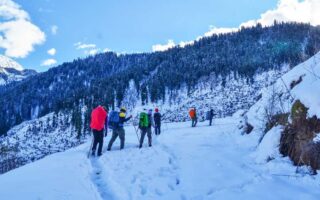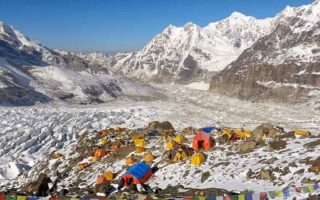The Kedarkantha Trek, located in the picturesque Garhwal region of Uttarakhand, India, is a magnificent adventure that attracts trekkers from all around the world. Known for its breathtaking views, serene environment, and the thrilling experience of trekking in snow during winter, the Kedarkantha Trek is perfect for both beginners and experienced trekkers alike. This comprehensive guide aims to provide you with all the information needed to plan your Kedarkantha Trek, including travel logistics, fitness preparation, essential gear, and safety tips.
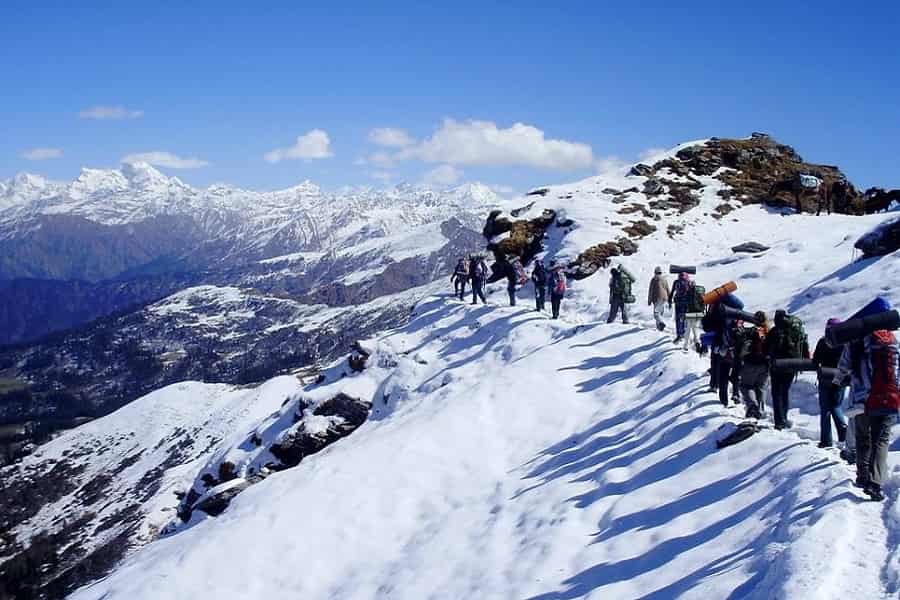
Table of Contents
ToggleOverview of Kedarkantha Trek
Trekking Route
The Kedarkantha Trek starts from the quaint village of Sankri, which serves as the base camp. The trek typically takes about 6-7 days, covering a distance of approximately 20 km each way, depending on the chosen route. The trek takes you through beautiful pine forests, charming villages, and stunning meadows, with the summit reaching an elevation of 12,500 feet.
1.2 Best Time to Trek
The best time to undertake the Kedarkantha Trek is during the winter months (December to March) when the region is blanketed in snow, offering a magical landscape. However, spring (April-May) and autumn (September-November) are also good times to trek, with pleasant weather and clear views.
Trek Difficulty Level
The Kedarkantha Trek is classified as an easy to moderate trek, making it suitable for beginners with a reasonable level of fitness. However, the trek can be challenging due to varying weather conditions and steep ascents.
How to Reach Dehradun
Before heading to Sankri, you must first reach Dehradun, the capital of Uttarakhand. Here are the primary modes of transport to reach Dehradun:
By Air
The nearest airport to Dehradun is Jolly Grant Airport, located approximately 25 km from the city center. Regular flights operate from major cities like Delhi, Mumbai, and Kolkata. Once you arrive at the airport, you can hire a taxi or take a bus to reach the city.
By Train
Dehradun is well-connected by rail to major cities in India. The main railway station is Dehradun Railway Station, which has direct trains from Delhi, Mumbai, Kolkata, and other cities. Popular trains include the Nandadevi Express and Dehradun Express. Upon arrival at the railway station, you can easily hire a taxi or take a bus to reach Sankri.
By Bus
Regular bus services operate between Delhi and Dehradun, with both AC and non-AC options available. The main bus station in Delhi is ISBT Kashmere Gate. It is advisable to choose government buses for a safe and comfortable journey.
Dehradun to Sankri
From Dehradun, you will need to travel to Sankri, the base camp for the Kedarkantha Trek. There are several options:
- By Taxi: Hire a taxi from Dehradun to Sankri. The distance is about 200 km, and the journey takes around 8-10 hours.
- By Bus: You can take a government or private bus from Dehradun to Sankri. However, buses may not run frequently, so check the schedule in advance.
Preparing for the Kedarkantha Trek
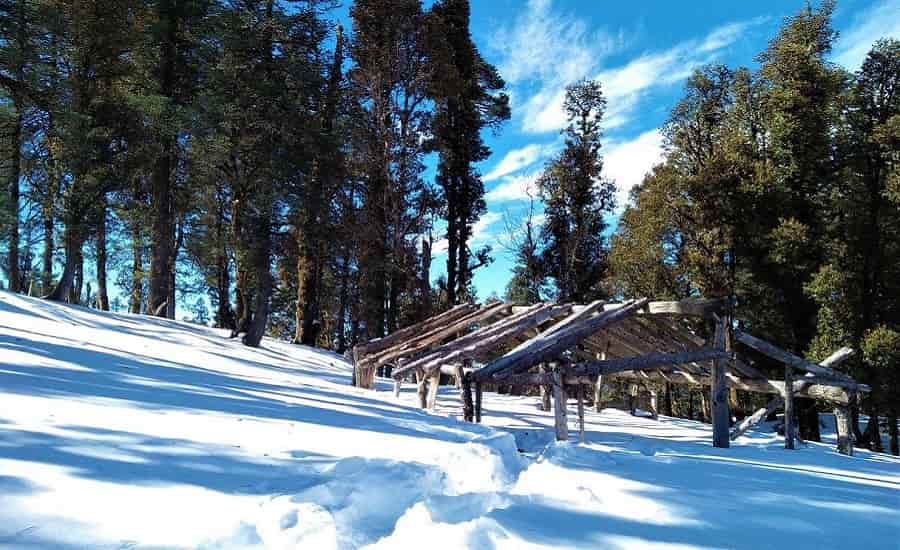
Fitness Preparation
Physical fitness is crucial for a successful trek. Here’s a preparation guide to help you build the necessary endurance and strength:
Cardiovascular Fitness
- Jogging: Incorporate jogging into your routine, aiming for at least five days a week. Start with shorter distances and gradually increase to 5 km.
- Interval Training: Include interval training in your workouts to enhance stamina and speed. Alternate between jogging and sprinting.
Strength Training
Focus on building strength in your lower body, upper body, and core. Key exercises include:
- Squats: Great for building leg strength. Aim for 3 sets of 10-15 repetitions.
- Lunges: Strengthen your legs and improve balance. Perform 3 sets of 10 repetitions per leg.
- Push-Ups: Develop upper body strength. Start with 3 sets of 8-10 repetitions.
- Planks: Strengthen your core. Hold for 30-60 seconds for 3 sets.
Hiking Practice
If possible, go for shorter hikes on weekends to acclimatize yourself to walking on uneven terrain while carrying a backpack.
Mental Preparation
Trekking can be physically and mentally challenging. Mental resilience is equally important. Here are some tips:
- Visualization: Imagine yourself successfully reaching the summit and enjoying the views.
- Positive Mindset: Maintain a positive attitude, even when faced with difficulties.
- Adaptability: Be prepared to adjust your plans and expectations based on weather conditions and other factors.
Packing Essentials for Kedarkantha Trek
Packing the right gear is crucial for a comfortable and enjoyable trekking experience. Here’s a detailed list of essentials to carry:
Clothing
- Base Layer: Moisture-wicking t-shirts and thermal tops for warmth.
- Insulating Layer: Fleece or down jackets to keep warm during colder temperatures.
- Outer Layer: Waterproof and windproof jacket to protect against rain and wind.
- Trekking Pants: Quick-dry and breathable trekking pants.
- Thermal Wear: For warmth at higher altitudes.
- Socks: Multiple pairs of moisture-wicking socks.
- Warm Hat & Gloves: Essential for keeping warm in colder conditions.
- Gaiters: Useful for walking in snow and keeping your feet dry.
Footwear
- Trekking Boots: High ankle, waterproof trekking boots with good grip.
- Camp Shoes: Lightweight sandals or shoes for comfort at the campsite.
Backpack
- Daypack: A comfortable, lightweight backpack to carry your essentials during the trek.
- Main Backpack: A larger backpack for carrying your gear and supplies.
Sleeping Gear
- Sleeping Bag: A good quality, insulated sleeping bag rated for sub-zero temperatures.
- Sleeping Mat: For added comfort while sleeping on the ground.
Trekking Gear
- Trekking Poles: Useful for maintaining balance and reducing strain on knees during ascents and descents.
- Headlamp/Flashlight: Essential for navigating in low light conditions.
Personal Items
- First Aid Kit: Include basic medications, band-aids, antiseptic wipes, etc.
- Toiletries: Biodegradable soap, toothbrush, toothpaste, and toilet paper.
- Water Bottle/Hydration Pack: Stay hydrated during your trek.
- Snacks: Energy bars, nuts, or trail mix for quick energy boosts.
Navigation & Safety
- Map & Compass: Helpful for navigation if needed.
- Multi-tool or Knife: Useful for various tasks during the trek.
- Emergency Whistle: For safety and signaling for help if needed.
Electronics
- Power Bank: To keep your devices charged.
- Camera: For capturing the stunning landscapes.
The Trekking Itinerary
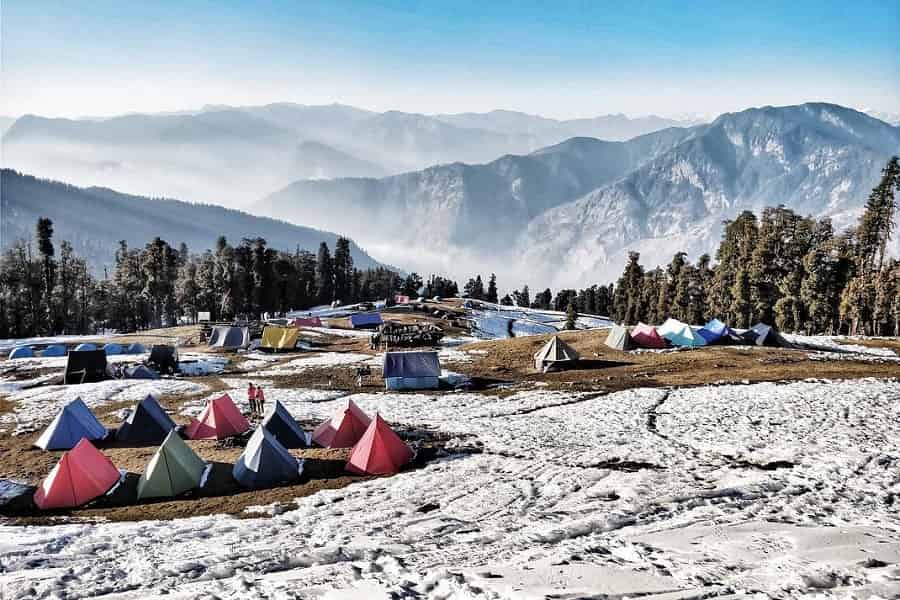
A typical itinerary for the Kedarkantha Trek spans around 6 days. Here’s a sample itinerary to give you an idea of what to expect:
Day 1: Dehradun to Sankri
- Depart from Dehradun in the morning.
- Arrive at Sankri by evening, settle into your accommodation.
- Briefing session about the trek and safety guidelines.
Day 2: Sankri to Juda Ka Talab
- Trek from Sankri to Juda Ka Talab (approximately 5 km).
- Enjoy scenic views and lush pine forests.
- Set up camp by the beautiful Juda Ka Talab lake.
Day 3: Juda Ka Talab to Kedarkantha Base Camp
- Trek from Juda Ka Talab to Kedarkantha Base Camp (approximately 5 km).
- Ascend through beautiful meadows and enjoy stunning views.
- Set up camp at the base, rest, and prepare for the summit.
Day 4: Summit Day – Kedarkantha Peak
- Start early for the summit (around 3 AM).
- Reach the peak by sunrise, enjoy panoramic views of the Himalayas.
- Return to Base Camp, pack up, and trek back to Juda Ka Talab.
Day 5: Juda Ka Talab to Sankri
- Trek back to Sankri from Juda Ka Talab.
- Arrive at Sankri and relax at the campsite or accommodation.
Day 6: Sankri to Dehradun
- Depart from Sankri in the morning.
- Arrive back in Dehradun by evening.
Safety Tips for Trekking
Acclimatization
- Give your body time to adjust to the altitude. If you experience symptoms of altitude sickness (headaches, nausea, dizziness), descend to a lower altitude and rest.
Stay Hydrated
- Drink plenty of water throughout the trek to stay hydrated. Carry a water bottle or hydration pack and refill at safe sources.
Follow the Guide
- If you’re trekking with a group or a guide, always follow their instructions and stay close to the group.
Weather Awareness
- Be aware of changing weather conditions. Check the weather forecast before your trek and be prepared for sudden changes.
Emergency Preparedness
- Familiarize yourself with emergency procedures and have a plan in place in case of accidents or injuries.
Respect Nature
- Follow Leave No Trace principles. Avoid littering and respect the local wildlife and environment.
FAQs about the Kedarkantha Trek
1. What is the best time to go on the Kedarkantha Trek?
- The best time to trek Kedarkantha is during winter (December to March) when the region is covered in snow. However, spring (April-May) and autumn (September-November) are also great options for trekking due to pleasant weather and clear views.
2. Is the Kedarkantha Trek suitable for beginners?
- Yes, the Kedarkantha Trek is classified as easy to moderate, making it suitable for beginners with a reasonable level of fitness. However, some prior trekking experience is beneficial.
3. How difficult is the trek?
- The trek involves moderate difficulty due to altitude and varying terrain, but with proper preparation and fitness, most trekkers can manage it successfully.
4. Do I need to hire a guide for the Kedarkantha Trek?
- While it is possible to trek independently, hiring a guide is recommended, especially for beginners. Guides provide valuable insights, ensure safety, and help navigate the trails.
5. What permits are required for the Kedarkantha Trek?
- You will need to obtain an entry permit from the forest department for trekking in the Kedarkantha region. This can usually be arranged through your trekking operator.
6. What kind of accommodation can I expect during the trek?
- Accommodation varies from tents to guesthouses in base camps. Most trekking operators provide camping facilities with tents and meals included.
7. How should I prepare physically for the trek?
- Focus on building cardiovascular endurance and strength through activities like jogging, strength training, and practice hikes. Aim for a fitness routine that includes lower body and core exercises.
8. What gear do I need for the trek?
- Essential gear includes waterproof trekking boots, warm clothing, a good quality sleeping bag, a backpack, trekking poles, and a first-aid kit. Refer to the packing essentials section for a complete list.
9. Are there any risks involved in the trek?
- Like any trek in the mountains, there are risks such as altitude sickness, weather changes, and injuries. Being aware of your body, staying hydrated, and following safety precautions can mitigate these risks.
10. Can I trek Kedarkantha solo?
- While solo trekking is possible, it is not recommended for inexperienced trekkers. Hiring a guide or joining a group can enhance safety and provide companionship during the trek.
Conclusion
The Kedarkantha Trek is a mesmerizing experience, offering stunning views, serene landscapes, and the thrill of adventure. By planning your trek carefully, preparing physically, and packing the right gear, you can ensure a memorable journey in the Himalayas. Whether you’re a seasoned trekker or a beginner, the Kedarkantha Trek promises an unforgettable adventure that will leave you with lasting memories and a desire to explore more of the beautiful Indian Himalayas. Happy trekking!
Suggested to Read

